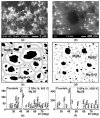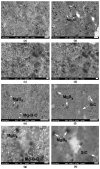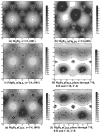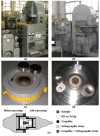Bulk MgB2 Superconducting Materials: Technology, Properties, and Applications
- PMID: 38894049
- PMCID: PMC11173785
- DOI: 10.3390/ma17112787
Bulk MgB2 Superconducting Materials: Technology, Properties, and Applications
Abstract
The intensive development of hydrogen technologies has made very promising applications of one of the cheapest and easily produced bulk MgB2-based superconductors. These materials are capable of operating effectively at liquid hydrogen temperatures (around 20 K) and are used as elements in various devices, such as magnets, magnetic bearings, fault current limiters, electrical motors, and generators. These applications require mechanically and chemically stable materials with high superconducting characteristics. This review considers the results of superconducting and structural property studies of MgB2-based bulk materials prepared under different pressure-temperature conditions using different promising methods: hot pressing (30 MPa), spark plasma sintering (16-96 MPa), and high quasi-hydrostatic pressures (2 GPa). Much attention has been paid to the study of the correlation between the manufacturing pressure-temperature conditions and superconducting characteristics. The influence of the amount and distribution of oxygen impurity and an excess of boron on superconducting characteristics is analyzed. The dependence of superconducting characteristics on the various additions and changes in material structure caused by these additions are discussed. It is shown that different production conditions and additions improve the superconducting MgB2 bulk properties for various ranges of temperature and magnetic fields, and the optimal technology may be selected according to the application requirements. We briefly discuss the possible applications of MgB2 superconductors in devices, such as fault current limiters and electric machines.
Keywords: effect of impurity oxygen; magnesium diboride bulk superconductors; pinning; structural study; superconducting properties.
Conflict of interest statement
The authors declare no conflict of interest.
Figures





























Similar articles
-
Synthesis of Dense MgB2 Superconductor via In Situ and Ex Situ Spark Plasma Sintering Method.Materials (Basel). 2021 Dec 2;14(23):7395. doi: 10.3390/ma14237395. Materials (Basel). 2021. PMID: 34885551 Free PMC article.
-
The Influence of Preparation Temperature on the Different Facets of Bulk MgB2 Superconductors.Micromachines (Basel). 2023 Apr 30;14(5):988. doi: 10.3390/mi14050988. Micromachines (Basel). 2023. PMID: 37241612 Free PMC article.
-
High critical currents in iron-clad superconducting MgB2 wires.Nature. 2001 May 31;411(6837):563-5. doi: 10.1038/35079030. Nature. 2001. PMID: 11385565
-
Progress on the Fabrication of Superconducting Wires and Tapes via Hot Isostatic Pressing.Materials (Basel). 2023 Feb 22;16(5):1786. doi: 10.3390/ma16051786. Materials (Basel). 2023. PMID: 36902902 Free PMC article. Review.
-
'Beautiful' unconventional synthesis and processing technologies of superconductors and some other materials.Sci Technol Adv Mater. 2011 Jan 12;12(1):013001. doi: 10.1088/1468-6996/12/1/11660943. eCollection 2011 Feb. Sci Technol Adv Mater. 2011. PMID: 27877374 Free PMC article. Review.
Cited by
-
Processing of Bulk MgB2 Superconductors by Coupling Laser Powder Bed Fusion and Spark Plasma Sintering Techniques.Materials (Basel). 2025 May 19;18(10):2367. doi: 10.3390/ma18102367. Materials (Basel). 2025. PMID: 40429104 Free PMC article.
References
-
- Koblischka-Veneva A., Koblischka M.R., Berger K., Nouailhetas Q., Douine B., Muralidhar M., Murakami M. Comparison of Temperature and Field Dependencies of the Critical Current Densities of Bulk YBCO, MgB2, and Iron-Based Superconductors. IEEE Trans. Appl. Supercond. 2019;29:1–5. doi: 10.1109/TASC.2019.2900932. - DOI
-
- Erbe M., Hänisch J., Freudenberg T., Kirchner A., Mönch I., Kaskel S., Schultz L., Holzapfel B. Improved REBa2Cu3O7−x (RE = Y, Gd) structure and superconducting properties by addition of acetylacetone in TFA-MOD precursor solutions. J. Mater. Chem. A. 2014;2:4932–4944. doi: 10.1039/C3TA15243J. - DOI
-
- Briant C.L., Hall E.L., Lay K.W., Tkaczyk I.E. Microstructural evolution of the BSCCO-2223 during powder-in-tube processing. J. Mater. Res. 1994;9:2789–2808. doi: 10.1557/JMR.1994.2789. - DOI
-
- Beales T.P., Jutson J., Le Lay L., Mölgg M. Comparison of the powder-in-tube processing properties of two (Bi2-xPbx)Sr2Ca2Cu3O10+δ powders. J. Mater. Chem. 1997;7:653–659. doi: 10.1039/A606896K. - DOI
-
- Ballarino A. HTS Materials for LHC Current Leads. [(accessed on 23 November 2005)]. Available online: https://at-mel-cf.web.cern.ch/html/HTS_materials.htm.
Publication types
LinkOut - more resources
Full Text Sources
Miscellaneous

